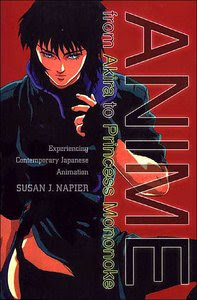Wednesday, November 4, 2009
Film books: Anime from Akira to Princess Mononoke: Experiencing Contemporary Japanese Animation by Susan J Napier
category: Film - books (Architecture and Film)
book index: 12
Title: Anime from Akira to Princess Mononoke: Experiencing Contemporary Japanese Animation
writer: Susan J Napier
editor/translator:
publisher: Palgrave Macmillan
published on: 2001
ISBN: 0312238622
volume: 336 pages
size: 1.05 Mb
reference: avaxhome.ws
description and download:
With the popularity of Pokémon still far from waning, Japanese animation, known as anime to its fans, has a firm hold on American pop culture. However, anime is much more than children's cartoons. It runs the gamut from historical epics to sci-fi sexual thrillers. Often dismissed as fanciful entertainment, anime is actually quite adept at portraying important social and cultural issues such as alienation, gender inequality, and teenage angst. This book investigates the ways that anime presents these issues in an in-depth and sophisticated manner, uncovering the identity conflicts, fears over rapid technological advancement, and other key themes present in much of Japanese animation.
The book uses literary criticism to discuss themes and ideas present in select anime titles and attempts to categorise anime into three types - apocalyptic, festival, and elegaic. The book is split into five sections. In the first, Napier asks why anime is important as a topic of study. In the second, Napier looks at the representation of the human body in anime, looking at "monstrous adolescents", pornographic anime and cyborgs. In the third, Napier looks at representations of females, the girl, the magical girl and magical girlfriends. In the fourth section, Napier examines historical-themed anime.
The "monstrous adolescent" is often a quick-tempered or psychologically disturbed child with remarkable and world-changing powers, which were usually a result of scientific experiments, revolutionary technology, or human-caused pollution. These children have the power to improve or alter the world , but because of their personality the child is often on the verge of destroying it completely. The source of this create/destroy idea is usually traced back to the effects of Hiroshima and the capabilities of nuclear power and atomic bombs. The theme of the "monstrous adolescent" explores society's fears of ever-growing technology, the rebellious actions of children, and the apocalyptic scenarios that are suggested by combining these two themes.
Download:
uploading link
link: http://uploading.com/files/GZFQKBN8/e1a.rar.html
Labels:
books
Subscribe to:
Post Comments (Atom)
disclaimer
film-and-architecture.blogspot as a section of architecturalvdos.blogspot or any other blogs in this architectural series (casestudies,theories, monographs, interviews, lectures, videos, books, magazines, standards, histories, supports, architects) does not host any of the files mentioned on this blog or on its own servers. film-and-architecture.blogspot only points out to various links on the Internet that already exist and are uploaded by other websites or users there. To clarify more please feel free to contact the webmasters anytime or read more
Here.
Here.



0 comments:
Post a Comment